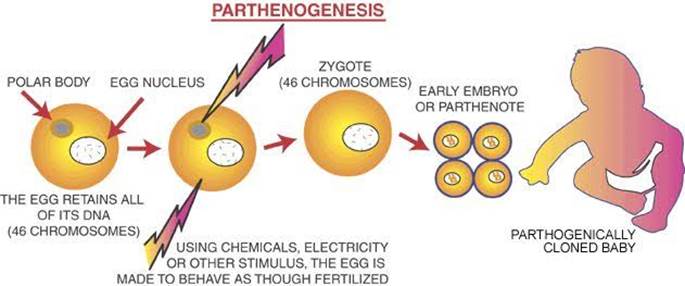Advanced reproductive techniques in Mahabharata
The Mahabharata is one of the 2 major epics of ancient India, the other being the Ramayana. Mahabharata is an encyclopedic coverage of ancient history. It narrates the events and aftermath of Kurukshetra war between two groups of princely cousins the Kauravas and Pandavas. The authorship of Mahabharata is accredited to the sage Vyasa. He is not only the author but also a leading character within it. The saga also praises lord Ganesha for writing down the verses as Vyasa dictated.
Descriptions
of episodes related to certain reproductive events are discussed here and are
remarkable.
The Mahabharata and Parthenogenesis
Parthenogenesis or “virgin birth” is a natural form of an asexual reproduction where an embryo develops directly from an unfertilized egg. A female can produce an embryo without fertilizing an egg with sperm. It occurs naturally in some animals like certain lizards (whiptail lizard) in insects (like honeybees and ants).
Humans cannot reproduce naturally through parthenogenesis. Parthenogenetic activation of human oocytes can lead to the development of teratomas in the ovary and sometimes result in early embryonic development resembling a fetus, fetiform teratomas. However spontaneous cases of parthenogenesis have been reported in infertile women treated with assisted reproductive technologies. The diagnosis was confirmed through the biopsy samples of embryo which were compatible with those from the maternal side.
Many examples of parthenogenesis are described in the Mahabharata. The “Divine birth”/virgin birth or asexual reproduction described in Mahabharata is an example of parthenogenesis. Here asexual reproduction is depicted through Kunti’s ability to conceive children from divine beings after receiving a blessing; Kunti using a mantra, conceive Karna from the Sun God-Surya without physical intimacy and later Yudhistir, Bhima, and Arjuna from other deities using the same mantra at the request of her husband Pandu. (Pandu the King of Hastina pura who could not perform coitus without surviving. He was cursed by a sage to die if he indulged in coitus. Pandu had shot at a mating pair of deer, who were actually a sage and his wife.) The same mantra was utilized by Kunti to allow her co-wife, madri to conceive Nakula and Sahadev. The “fathers” of five Pandavas are Yama, Vayu, Indra and the twin Ashwins.
The Mahabharata and Pseudocyesis /prolonged gestation
In Mahabharata 100 Kauravas and one daughter Dushala were born to Gandhari and Dhristrashtra. Gandhari’s “pregnancy” was a case of pseudocyesis. The epic narrates Gandhari as having prolonged gestation, after that she gave birth to a lump of immovable flesh. Then Kauravas are born from the mass of flesh divided into 100 pieces nurtured in jars and incubated. Finally, 101 children were born which has been equated to modern embryo culture.
Potential significance
Parthenogenesis gives a new hypothesis for the rare phenomenon that may occur in humans. Moreover, parthenogenesis could be developed to enhance the formation of stem cells and body tissues used in organ transplantation and regenerative medicine in the future.
Gandhari’s description is strongly reminiscent of IVF -Invitro fertilization with multiple pregnancies. This documentation imitates an extrauterine gestation, a scientific fact that prospective researches may be able to achieve. Some scholars interpret these events as examples of advanced reproductive techniques, including assisted reproduction and embryo culture that were known or conceptualized in ancient days.
References:
1.The Mahabharata Tirupati. Krishnamacharya NM. Tirumala Tirupati devasthanams;2012
2.Bos-Mikich A, Bressan FF, Ruggeri RR, Watanabe Y. Parthenogenesis and human assisted reproduction. Stem cells Int 2016; 1970843:1-8
3.Oliveria FG, Dozortsev D,et al . Diamond MP, et al. Evidence of parthenogenetic origin of ovarian teratoma. Hum Reprod 2004; 19:1867-1870
4.Jiang Y, Song G, Yuan JC, Zhang XH, Genetic analysis of recurrent parthenogenesis: A case report and literature review. Exp Ther Med 2022; 24:530
5.Combelles CMH ,Kearns WG, Fox JH Cellular and genetic analysis of oocytes and embryos in a human case of spontaneous oocyte activation. Hum Reprod 2011; 26:545-552
6.Ye Y, Li N, Yan X, Wu R, Zhou W, Cheng L et al. Genetic analysis of embryo in a human case of spontaneous oocyte activation. A case report. Gynecol Endocrinol 2020;36:294-296

